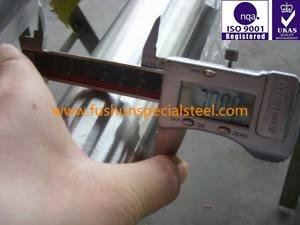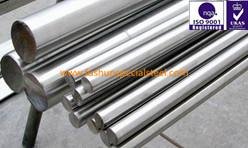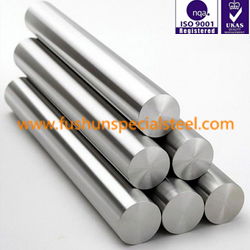| Model: | F55 |
|---|---|
| Brand: | Fushun |
| Origin: | Made In China |
| Category: | Metallurgy , Mining & Energy / Metallurgy & Mining / Stainless Steel |
| Label: | UNS S32205 , 1.4462 , F55 |
| Price: |
US $2000
/ ton
|
| Min. Order: | 1 ton |
Product Description
Introduction
2205 duplex stainless steel is a 22% Chromium, 3% Molybdenum, 5-6% Nickel nitrogen alloyed duplex stainless steel with high general, localized and stress corrosion resistance properties in addition to high strength and excellent impact toughness.
2205 duplex stainless steel provides pitting and crevice corrosion resistance superior to 316L or 317L austenitic stainless steels in almost all corrosive media. It also has high corrosion and erosion fatigue properties as well as lower thermal expansion and higher thermal conductivity than austenitic.
The yield strength is about twice that of austenitic stainless steels. This allows a designer to save weight and makes the alloy more cost competitive when compared to 316L or 317L.
2205 duplex stainless steel is particularly suitable for applications covering the -50째F/+600째F temperature range. Temperatures outside this range may be considered but need some restrictions, particularly for welded structures.
Applications
- Chemical processing, transport and storage – pressure vessels, tanks, piping, and heat exchangers
- Oil and gas exploration and processing equipment – piping, tubing, and heat exchangers
- Marine and other high chloride environments
- Effluent scrubbing systems
- Pulp and paper industry – digesters, bleaching equipment, and stock-handling systems
- Cargo tanks for ships and trucks
- Food processing equipment
- Biofuels plants
Quality Standard
ASTM A182 Standard Specification for Forged or Rolled Alloy-Steel Pipe Flanges, Forged Fittings, and Valves and Parts
ASTM A276 Standard Specification for Stainless Steel Bars and Shapes
EN 10088 part3 stainless steel
ASTM A240 Standard Specification for Chromium and Chromium Nickel Stainless Steel Plate Sheet and Strip
All Grades Comparison
ASTM A240: UNS S32205/S31803
EN10088:1.4462 X2CrNiMoN 22.5.3
AFNOR:Z3 CrNi 22.05 AZ
Chemical Composition(%)
2205 C:0.03max, Si:1.0max, Mn:2.0max, P:0.030max, S:0.020max. Cr:22.0-23.0, Ni:4.50-6.50, Mo:3.0-3.5, N:0.14-0.20
1.4462 C:0.03max, Si:1.0max, Mn:2.0max, P:0.035max, S:0.015max, Cr:21.0-23.0, Ni:4.50-6.50, Mo:2.50-5.50, N:0.10-0.22
Mechanical Properties (Annealed)
Hardness (HB):270max
Tensile Strength (Mpa):650-880
Yield Strength (Mpa):450min
Elongation (%) (Long.):25min
Impact Value (J) (Long.):100min
Corrosion Resistance
General Corrosion: Because of its high chromium (22%), molybdenum (3%), and nitrogen (0.18%) contents, the corrosion resistance properties of 2205 duplex stainless steel are superior to that of 316L or 317L in most environments.
Localized Corrosion Resistance: The chromium, molybdenum, and nitrogen in 2205 duplex stainless steel also provide excellent resistance to pitting and crevice corrosion even in very oxidizing and acidic solutions.
Stress Corrosion Resistance: The duplex microstructure is known to improve the stress corrosion cracking resistance of stainless steels.
Chloride stress corrosion cracking of austenitic stainless steels can occur when the necessary conditions of temperature, tensile stress, oxygen, and chlorides are present. Since these conditions are not easily controlled, stress corrosion cracking has often been a barrier to utilizing 304L, 316L, or 317L.
Corrosion Fatigue Resistence: 2205 duplex stainless steel combines high strength and high corrosion resistance to produce high corrosion fatigue strength. Applications in which processing equipment is subject to both an aggresively corrosive enviroment and to cycle loading can benefit from the properties of 2205 duplex stainless steel.
Processing
Hot Forming: Forming below 600°F is recommended whenever possible. When hot forming is required, the workpiece should be heated uniformly and worked in the range of 1750 to 2250°F. 2205 duplex stainless steel is quite soft at these temperatures and is readily formed. Above this range, 2205 duplex stainless steel is subject to hot tearing. Immediately below this range, the austenite becomes substantially stronger than the ferrite and may cause cracking, a particular danger to “cold” edges. Below 1700°F there can be rapid formation of intermetallic phases because of the combination of temperature and deformation. Whenever hot forming is done, it should be followed by a full solution anneal at 1900°F minimum and rapid quench to restore phase balance, toughness, and corrosion resistance. Stress relieving is not required or recommended; however, if it must be performed, the material should receive a full solution anneal at 1900°F minimum, followed by rapid cooling or water quenching.
Cold Forming: 2205 duplex stainless steel is readily sheared and cold formed on equipment suited to working stainless steels. However, because of the high strength and rapid work hardening of 2205 duplex stainless steel, forces substantially higher than those for austenitic steels are required to cold form it. Also because of the high strength, a somewhat larger allowance must be made for springback.
Heat Treatment:2205 duplex stainless steel should be annealed at 1900°F minimum, followed by rapid cooling, ideally by water quenching. This treatment applies to both solution annealing and stress relieving. Stress relief treatments at any lower temperature carry the risk of precipitation of detrimental intermetallic or nonmetallic phases.
Structure
The chemical analysis of 2205 duplex stainless steel is optimized to obtain a typical 50 a/ 50 g microstructure after solution annealing treatment at 1900°/1922°F (1040°/1080°C). Heat treatments performed above 2000°F may result in an increase of ferrite content.
Like all duplex stainless steels, 2205 duplex stainless steel is susceptible to precipitation of intermetallic phases, usually referred to as sigma phase. Intermetallic phases precipitate in the range of 1300°F to 1800°F, with the most rapid precipitation occurring at about 1600°F. Thus, it is prudent to have 2205 pass a test for the absence of intermetallic phases, such as those in ASTM A923.
Mill′s test certificate
EN 10204/3.1 with all relevant data reg. chem. composition, mech. properties and results of testing.
Member Information
| Hunan Fushun Metal Co.,Ltd | |
|---|---|
| Country/Region: | Hu Nan - China |
| Business Nature: | Trading Company |
| Phone: | 15111326206 |
| Contact: | Kate Yang (Sales Manager) |
| Last Online: | 04 Nov, 2016 |
Related Products of this Company
-
1.4545 UNS S15500 XM-12 15-5PH
US $2000
-
SUS 420J2 S136 X40Cr14 DIN1.2083 420
US $2000
-
Z3 CN 25.06 Az UNS S32750 DIN1.4410
US $2000
-
Cold Drawn 304 Stainless Steel Flat Bar
US $2000
-
1.4542 UNS S17400 630 17-4PH
US $2000
-
DIN1.4539 904L Stainless Steel
US $2000
-
1.4125 X105CrMo17 UNS S44004 440C
US $2000
-
DIN1.4539 904L Stainless Steel
US $2000
-
UNS S31254 1.4547 F44 Super Austenitic
US $2000
-
1.4112 X90CrMoV18 UNS S44003 440B
US $2000












